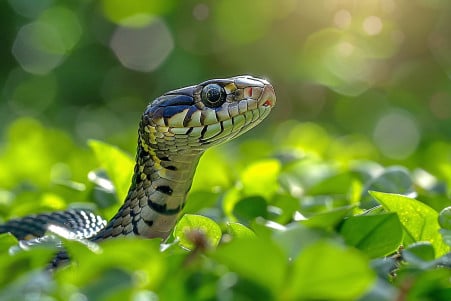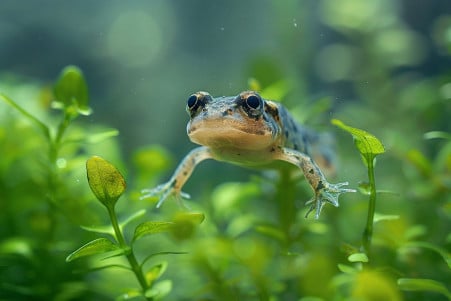What Do Baby Lizards Eat? Insights into Their Diet and Care
18 February 2024 • Updated 16 February 2024

If you’ve ever watched a baby lizard running around, you may have asked yourself what they eat. It turns out that baby lizards eat mostly small insects like ants, flies, and small worms, which is consistent with the diet of adult lizards but in smaller amounts.
If they are herbivorous, they eat tender leaves and fruit. If they are being raised in captivity, they require regular meals that are dusted with calcium and vitamin supplements to ensure they grow up healthy.
This article will take a deep dive into both zoological and veterinary research to uncover the interesting eating habits of baby lizards.
It will also look at herpetological research that has explored the nutritional needs and feeding patterns of baby lizards from a variety of species.
It’s important to know what these little creatures eat to ensure they grow up healthy whether they are living in the wild or being kept as pets. Not only will this information satisfy your curiosity, but it will also help lizard lovers make sure they are taking the best care of their scaly friends.
What do baby lizards eat?
Feeding Finesse: Diet Diversity in Baby Lizards
The dietary needs of baby lizards are as diverse as the many species that make up the world of lizards. There is no one-size-fits-all diet in the lizard world. Some lizards, like the carnivorous Jaragua lizard, eat small insects like aphids and mites. Meanwhile, others, like the green iguana and uromastyx, are mostly herbivorous from birth, eating a variety of soft plants, according to A-Z Animals.
For pet owners, understanding the diet of the species they own is essential. For example, bearded dragons, one of the most popular pet lizards, are omnivores. They need a diet high in protein when they are babies, with about 80% of their diet coming from animal sources and 20% from plant sources to help them grow.
This ratio changes as they age, according to VCA Animal Hospitals. Leopard geckos, on the other hand, are obligate insectivores, which means they don’t eat fruits and vegetables and instead eat only insects, according to Build Your Aquarium.
Pet owners need to make sure they are feeding their baby lizards the right diet to ensure their health and well-being. This includes making sure they are feeding their lizards the right ratio of different types of food and making sure they are feeding them the right types of food.
This is something that will change as the lizards grow, which leads to the next important part of their care: making sure they are getting the right nutrition to grow as they should.
Meeting the Demands of Growth: Baby Lizard Diet
Baby lizards have very specific dietary needs that are especially important during their growth spurt. This time requires a diet that is high in protein to support the rapid growth that occurs after hatching.
According to DVM360, the diet of a baby lizard is very different from that of an adult lizard and requires more frequent feedings to ensure that they get the protein and other nutrients they need in the right amounts to avoid overfeeding and promote good health.
Baby lizards that are kept as pets often need to have calcium and vitamin supplements added to their diet to ensure that they get the nutrients they would normally get in the wild, as explained by Arizona Exotics.
For example, bearded dragons eat more insects, which are high in protein, when they are young and gradually eat more greens as they get older. Cedar Creek Veterinary Clinic explains that this means that their diet will need to be adjusted as they age, and they recommend daily supplements for juveniles and bi-weekly supplements for adults.
Pet parents will want to make sure that they are feeding their baby lizards a well-rounded diet that includes the nutrients that they would have access to in the wild. This can be done by feeding them a combination of high-quality commercial lizard foods that are supplemented with the necessary vitamins and minerals and working with a vet to make sure that their diet is meeting their needs.
Navigating Nutrition: The Dietary Transition of the Captive Baby Lizard
The shift from the wild to captivity has a clear impact on the diet of baby lizards. In the wild, lizards have access to a range of foods that are in line with their natural feeding behaviors and help maintain a healthy gut microbiota, which is important for overall health.
However, captivity can disrupt these natural patterns. A study in Ecology and Evolution found that there were significant differences in the gut microbiota of wild and captive lizards, suggesting that the dietary changes that come with captivity can impact the lizard’s gut health.
Another study in PMC found that the diets of captive lizards are often less diverse and balanced than the diets of wild lizards, which can lead to nutritional deficiencies and changes in the gut microbiota.
This means that pet owners need to work to make sure that their lizard’s diet is as close to the lizard’s natural diet as possible to ensure that they stay healthy and avoid issues like malnutrition, which is a common problem in captive lizards according to the RSPCA Knowledgebase.
This means that owners need to make sure that they are constantly monitoring and adjusting their lizard’s diet, especially as their lizard grows and their nutritional needs change.
To make sure that their lizard’s diet is as close to their natural diet as possible and that their gut microbiota is as healthy as possible, owners need to use a variety of techniques including dietary enrichment, gut loading feeder insects with nutrient-dense foods, and adding essential vitamins and minerals to their lizard’s diet.
By making sure that they are meeting these needs, owners can help ensure that their reptile friends are healthy in their captive environment.
Avoiding Predation: The Delicate Dance of Baby Lizard Diets
In nature, survival tactics play a major role in the diets of baby lizards. The ability to hide, run quickly, and use other methods of evasion are important for avoiding predators and finding food. Birds, mammals, and other lizards are all predators that baby lizards must avoid.
As a result, the presence of predators has a big impact on how and what baby lizards eat. According to Bioexpedition, the need to avoid predation often leads baby lizards to use cryptic behaviors and feeding strategies to minimize their exposure to predators.
Baby lizards have evolved some fascinating physiological adaptations to these pressures. For example, tail autotomy, or the ability to drop their tails to escape predators, is a useful adaptation, but it comes with some trade-offs. A study in PMC notes that the energy baby lizards use to regenerate their tails is energy that could be used for growth, which shows that there is a delicate balance between survival and nutrition.
It’s important for people who are taking care of baby lizards in captivity to understand these survival adaptations. Creating a feeding environment that takes these natural instincts into account can help ensure the well-being of baby lizards. By minimizing stress and creating feeding situations that are as close to natural as possible, caregivers can help meet the natural needs of baby lizards and ensure their overall well-being.
Growth Phases: How Lizards’ Diets Change as They Grow
When baby lizards first hatch, they begin a process of growth and dietary change that is nothing short of amazing. In the beginning, they consume primarily insects to aid their development. However, as they mature from juveniles into adults, their diet changes significantly.
In species that are omnivorous or herbivorous, the amount of plant material in their diet increases. A study in PMC explains that environmental factors drive changes in things like morphology, including bite force, that then change what lizards can and want to eat.
It’s important to make sure that the lizards’ diets change to match these growth phases. For example, the rapid changes in diet and morphology that the lizard species Podarcis siculus goes through, which are explained in the Proceedings of the Royal Society B, show how important diet is in evolutionary changes.
In captivity, these changes are carefully managed by making sure that the lizards are fed a variety of foods that change as they grow to make sure that their needs are being met and that they stay healthy.
Knowing what growth phases are and what changes in diet occur during each phase helps ensure that the lizards are prepared for well-being and that they remain healthy as they progress with their owners.
In Conclusion: What to Feed a Baby Lizard
The care of baby lizards is dependent on their unique dietary needs, which can vary greatly from species to species. While some lizards are insectivores, others are herbivores. This means that their diets are very different and that their needs must be met in captivity. This includes the right food, the right nutrients, and the right feeding schedule and amounts to ensure that they grow up healthy and strong.
This article has shown that feeding baby lizards in captivity is all about maintaining their gut health and overall wellness, and that it can be a bit of a balancing act. It has also shown that the natural survival instincts of baby lizards in the wild can impact their feeding habits.
Finally, it’s important to remember that if you are a pet owner, it is your responsibility to make sure that your pet is getting the best care possible. This includes working with herpetologists and veterinarians to make sure that your pet lizard is getting the best diet for their needs.
By doing this, you can make sure that you are doing everything you can to keep your pet lizard healthy and happy. After all, taking care of a baby lizard is about more than just feeding it, it’s about nurturing it.


